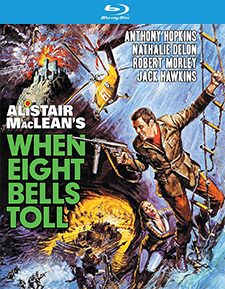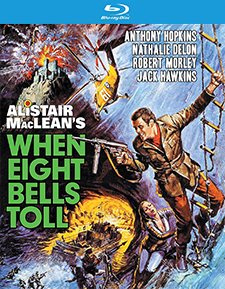When Eight Bells Toll (Blu-ray Review)

Director
Étienne PérierRelease Date(s)
1971 (July 16, 2024)Studio(s)
Gershwin-Kastner Productions (Kino Lorber Studio Classics)- Film/Program Grade: C+
- Video Grade: B+
- Audio Grade: B+
- Extras Grade: B
Review
Alistair MacLean’s novels have consistently translated into box office dollars when adapted into action movies, such as The Guns of Navarone, Where Eagles Dare, and Breakheart Pass. In the British-made film adaptation of MacLean’s When Eight Bells Toll, a secret service agent investigates the pirating of gold bullion in the Irish seas.
Philip Calvert (Anthony Hopkins, The Silence of the Lambs) is first seen approaching a hijacked ship from underwater, climbing up a massive anchor chain, and stealthily boarding. This opening scene establishes Calvert as a Bond-like super spy who can handle himself in dangerous assignments. But he appears not to have the full cooperation of his superiors, notably his handler Uncle Arthur (Robert Morley, Topkapi), a pompous and portly fussbudget who seems more concerned with having a proper lunch than with solving the mystery of the stolen bullion.
The likely mastermind is shipping magnate Sir Anthony Skouras (Jack Hawkins, Land of the Pharaohs). Skouras’ wife, the much younger Charlotte (Nathalie Delon, The Hand), takes a romantic interest in Calvert. But Calvert’s experience in the perilous world of secret agentry has led him to trust no one. He punches, kicks, shoots crossbows, and hangs from helicopters while trying to get to the bottom of the pirates’ plot and locate their hideout.
The film looks as if it aspires to be another 007-type adventure yet never achieves the cleverness of a Bond film. Director Etienne Perier doesn’t pace the scenes effectively, balancing dramatic scenes with action sequences, nor does he elicit from Hopkins the derring-do that his character requires. The action moments include helicopter crashes, chases at sea, underwater explorations of sunken ships, and rough-and-tumble fistfights but none of them are splashy enough to rivet the viewer. The Scottish coast doesn’t compare with some of the exotic locations in the Bond movies and Hopkins is not your ideal super spy.
There’s no denying Hopkins is a fine actor. In fact, he was cast after producer Elliott Kastner saw him in A Lion in Winter. But he doesn’t have the look of a rugged agent and his expression never reflects the danger at hand. He’s best at delivering Calvert’s repartee with Morley’s Uncle Arthur and making clear his dissatisfaction with his superior as he tiptoes around directly accusing him of indifference toward his responsibilities. Had the script not depended on so many intentional similarities to a Bond film, from the structure to the characters to the score, When Eight Bells Toll might have fared better with a distinction of its own.
Hawkins does some scenery chewing as the bad guy but doesn’t come into the film until about a third of the way. Skouras is neither as flamboyant nor as memorable as a Dr. No, a Goldfinger, or an Ernst Blofeld—an opportunity MacLean missed in writing the screenplay based on his own novel.
Nathalie Delon, though quite attractive, makes little impression as Charlotte and isn’t essential to the plot. Is she a good girl gone bad or a conscienceless mercenary? We’re never told, and all Delon can do with her limited role is look irritated, bored, and beautiful. We’re supposed to wonder where her loyalties lie, but that’s so obvious that subsequent revelations aren’t at all surprising. Her character is feminine window dressing in an otherwise testosterone-driven picture.
Robert Morley is the best thing about When Eight Bells Toll. His officious, persnickety Uncle Arthur is a distracted, arrogant, upper-class buffoon who perks up the film with some badly needed humor. Pontificating on trivial matters as he sits like Buddha passing judgment on Calvert, Morley is the epitome of class entitlement. Ascribing Calvert’s penchant for getting into tight spots to the fact that he didn’t go to the proper school, Uncle Arthur dismisses the notion that he, a man of high station, could possibly bear any blame for the troubles of his underlings. Morley’s distinctive delivery makes his exasperating character likable.
When Eight Bells Toll is notable as the film that tried to make an action hero out of Anthony Hopkins. To his credit, Hopkins works feverishly to prove himself an agile and able action hero, but being cast against type was an insurmountable flaw. The plan was to produce a series of spy films to compete with the lucrative Bond franchise, but after this one underperformed, the idea was dropped.
When Eight Bells Toll was shot by director of photography Arthur Ibbetson on 35 mm Eastmancolor film in the Panavision process and presented in the aspect ratio of 2.35:1. On the Blu-ray from Kino Lorber Studio Classics, clarity is somewhat soft, with details not as sharp as other Blu-ray releases of films from the same period. The color palette is broad but tends mostly toward earth tones of the Scottish coast and its rock formations, and the vast blue sea. There are occasional white specks visible throughout, but they’re not a major distraction. The ocean scenes are especially well filmed, with waves, Scuba gear, and Scuba bubbles nicely delineated. Underwater scenes vary from reasonably clear to murky. In one dark scene, flickering is visible.
The soundtrack is English 2.0 mono DTS-HD Master Audio. English SDH subtitles are available. Dialogue is clear and distinct, even aboard ships with wind and splashing waves in the background. Sound effects include bodies being pummeled in hand-to-hand fights, gun fire, a helicopter’s engine and spinning rotor blades, and boats moving quickly through the water. Walter Stott’s score amps excitement in action sequences and approaches in style music from the James Bond movies. Unfortunately, the music comes across rather thinly and without proper resonance.
Bonus materials on the Region A Blu-ray release from Kino Lorber Studio Classics include the following:
- Audio Commentary by Steve Mitchell and Cyrus Voris
- Trailer (2:50)
- Juggernaut Trailer (2:54)
- Masquerade Trailer (3:00)
- The Ipcress File Trailer (3:07)
- The Eiger Sanction Trailer (2:50)
- The Groundstar Conspiracy Trailer (2:37)
- Number One of the Secret Service Trailer (2:33)
- That Man Bolt Trailer (2:32)
- The Secret Ways Trailer (1:05)
- The Satan Bug Trailer (2:13)
- Breakheart Pass Trailer (3:07)
- Force 10 from Navarone Trailer (1:45)
Audio Commentary – Filmmaker/historian Steve Mitchell and screenwriter/producer Cyrus Voris note that the opening shot of Calvert climbing up the anchor chain was filmed with a stuntman and involved no CGI. The opening music with a touch of sleaziness suggests a “working class James Bond,” as it strives to create a theme for Philip Calvert. At the time of production, no one in the United States knew who Anthony Hopkins was, so his name isn’t dominant on the advertising poster. Alistair MacLean, known for writing action pictures, was regarded as the big draw. MacLean’s novels were popular for movie adaptions, and 15 films were made from his works. For When Eight Bells Toll, MacLean adapted his novel of the same title and followed its structure. Producer Elliott Kastner felt that When Eight Bells Toll could be the first in a new action series. Where Eagles Dare, a MacLean adaptation with style, stars, and scope, was a box office hit. Casting a star would have contributed to a stronger box office for When Eight Bells Toll. Hopkins turned down the role at first, thinking it was “too fast” for him. He wasn’t suave and hadn’t had posh schooling. Created primarily for the American market, the film is anti-glamour and “the antithesis of a Bond movie.” Jack Hawkins had throat cancer at the time of filming and was dubbed by Charles Gray. Bob Simmons staged the action sequences and often stepped in as stuntman. He put Hopkins on a rigorous training regimen that caused Hopkins to lose ten pounds. The film had a 16-week shooting schedule and a budget of $1.8 million. Nathalie Delon, playing the femme fatale, never made it in American films. Director Etienne Perier hadn’t done many American films and didn’t understand the rhythms of action pictures. The musical score works well in accompanying action sequences. Hopkins once noted, “Sex maniacs don’t make good spies.” The guiding principle of the picture seems to be if you can blow something up, blow it up. The film received mixed reviews and didn’t make a big enough impact on the market. Subsequent MacLean films “never caught fire” with audiences.
When Sean Connery stepped down from the role of James Bond, there appeared to be an opening for another spy franchise and When Eight Bells Toll was put into production. It failed to live up to expectations, with a poor choice for action hero and a director who was out of his depth in combining action, romance, and style. The suave Roger Moore would pick up the Bond torch and continue the 007 series, leaving When Eight Bells Toll as a failed attempt to recreate the magic and initiate its own series of spy flicks.
- Dennis Seuling

